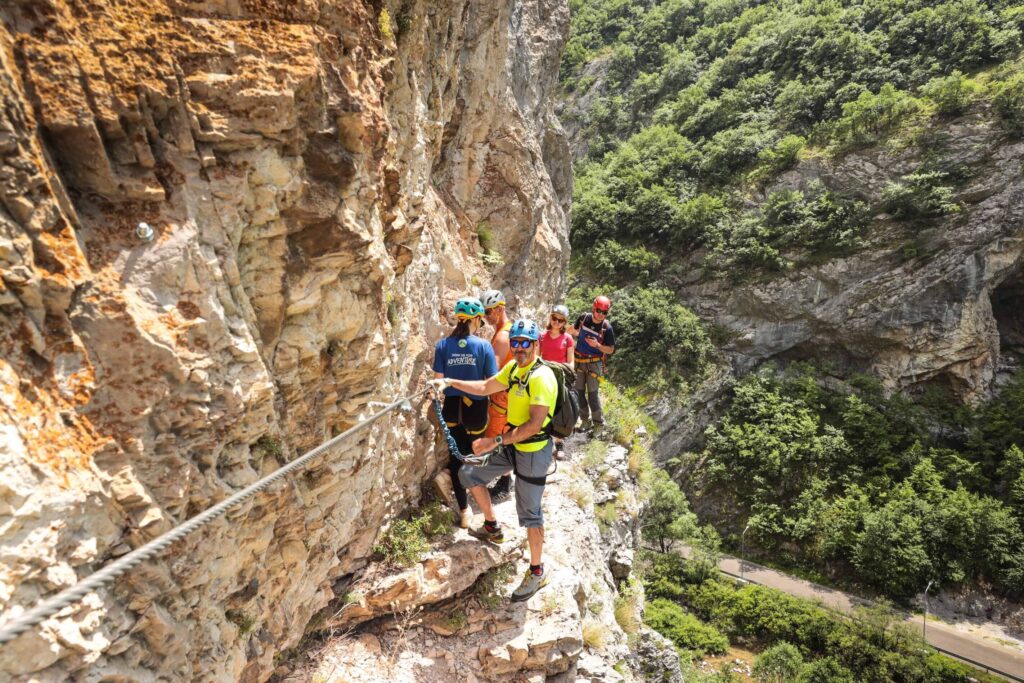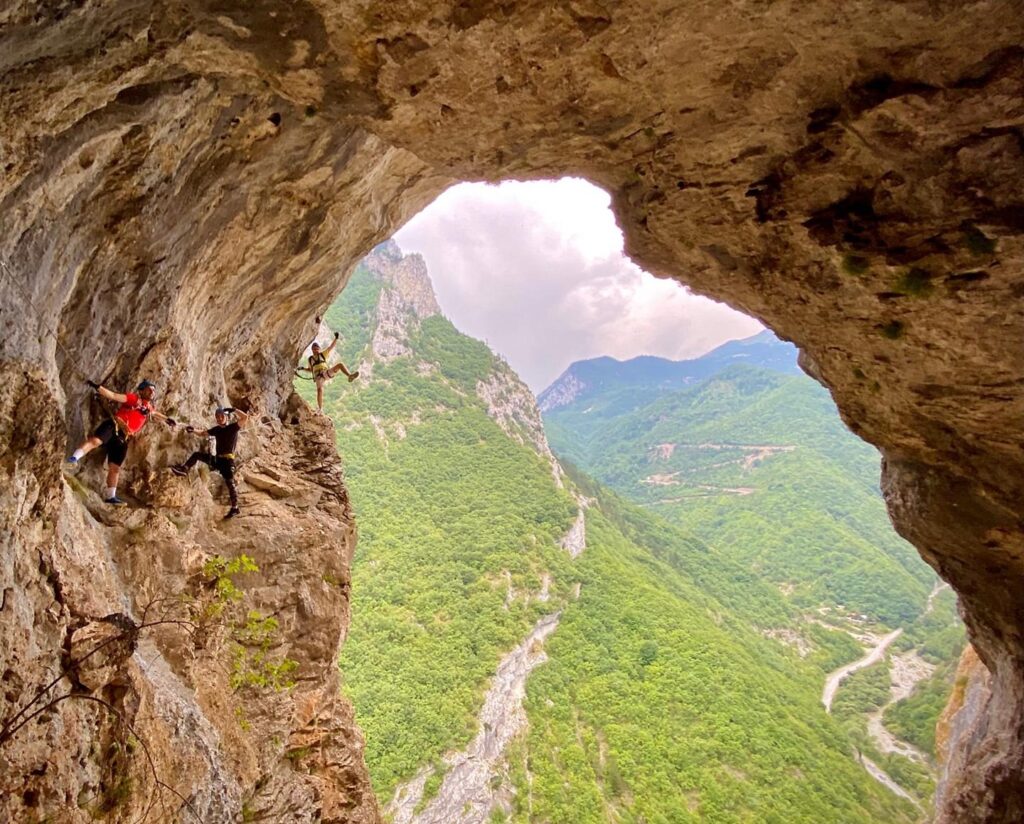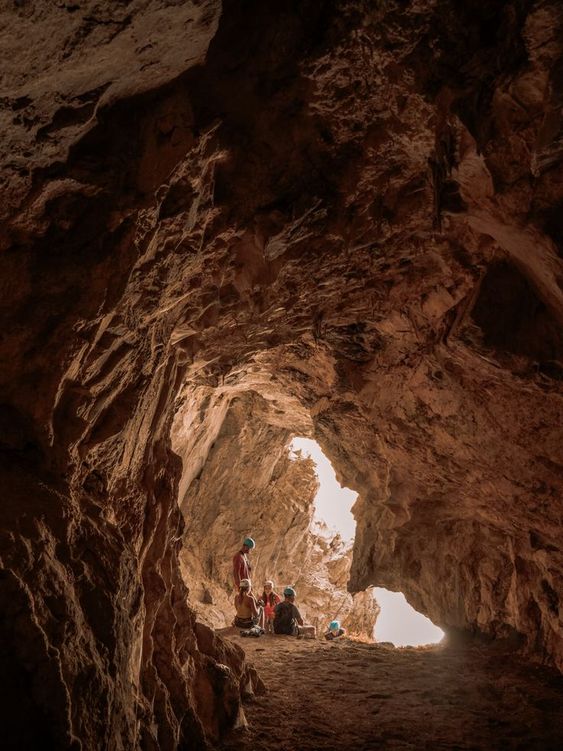Kosovo is new to offering Via Ferrata, with the first one opened only in 2015. However, the boom of Ferratas in Kosovo has made the country a top destination for Via Ferratas in the region. Kosovo now has eight different Via Ferratas. Four of them are situated in Peja in Gryka e Rugoves, and others different locations in Kosovo. Via Ferrata Deçani in Deçan, Via Ferrata Panorama in Prizren, one in Ferizaj reagion which is under construction and Via Ferrata Berim in Northern Kosovo, municipality of Zubin Potok.
Peja is the Via Ferrata heaven and offers different levels and lengths of ferratas. Via Ferrata Mat is the easiest and Marimangat is the most difficult. In between, you have Via Ferrata Ari, which is the first one constructed, and Via Ferrata Shpellat or Caves.

Via Ferrata Mat
The best decision is not which one to do but which one to do first! All Via Ferratas can be done in a five-day trip and will offer initial adrenaline and later expertise and zen calmness as you progress in enjoying the views and getting used to climbing the stairs in the rock.
To start, the best choice will be Via Ferrata Mat, which is the shortest and the closest to the city of Peja. This ferrata goes parallel to the river and gives a unique experience of walking on a trail carved naturally in the rock. This Via Ferrata ends close to the beginning of Via Ferrata Ari and Shpellat, which share the same beginning. For those that have a knack for adventure, they can do Via Ferrata Mat and Via Ferrata Ari in one go.
After Mat and Ari, Via Ferrata Shpellat can be a good experience. The difficulty will increase a notch, and the experience will be unique as the trail will go through caves with big openings giving unique views in the Rugova Gorge. For beginners, Via Ferrata Shpellat should be done only after Mat or Ari. The climb in Shpellat is more difficult, and without prior experience, the stress will be on the difficulty rather than the views and experience.

Via Ferrata Shpellat
To make your experience in Via Ferratas in Kosovo complete, one should do Via Ferrata Marimangat, which is the most difficult and starts with a spectacular walk on the Tyrolean bridge at a high altitude. The trail continues on the face of the rock, giving both views and adrenaline. In terms of difficulty, this is the most challenging climb. However, the two Via Ferratas in Deçan and Prizren offer other unique experiences.
This Ferrata is situated in the town of Deçan and in the gorge that connects the town with the high mountains used as pastures. The Ferrata route goes through a system of caves used by monks for centuries. While you climb and enjoy the natural beauty of the gorge, you will also see trails of drawings of iconography.
The climb in this Via Ferrata can be accompanied by a visit to The Deçani Monastery, which offers some of the best icons in Eastern Christian culture. What is particular in the monastery is that you can find the only drawing of Christ holding a sword. The gorge in Deçan also offers several restaurants that prepare traditional food and have a nice ambiance. Additionally, there is an adventure park for those traveling with families. The adventure park is situated in Belle Resort, located in the village of the same name. The resort offers accommodation, a restaurant, and a traditional kulla, decorated with insignia of the last war in Kosovo.
From Deçan, 60 kilometers south, you will get to Prizren, where Via Ferrata Panorama is situated. Here you will see the Sharr Mountains, whereas previously you were in the Accursed Mountains. The Ferrata itself offers unique views of the river and the gorge linking the city with towns and villages rich in pastures, producing cheese and milk.
In addition to the Via Ferrata, the city itself is another experience. Some call it a small Istanbul due to its rich religious diversity and the castle overlooking the city. Here you can close your Via Ferrata and cultural experience in Kosovo, which is unique for the region and worldwide due to the spread of the Ferrata in two different mountain ranges surrounded by amazing cultural and culinary experiences.
Via Ferrata Berim is situated in the north of the country, bordering Serbia. This Ferrata is in a completely different mountain range, and the region is also known for the huge water reservoir called Gazivoda. This major lake gathers water from the Ibar River and provides drinking water for the municipalities surrounding the lake and the Kosovo coal-run power plants.
This is a very long Via Ferrata with a diagonal stair connecting two ridges in the form of a bridge. The construction style is different, as the steps have only one turn versus four in the other Via Ferratas. The Ferrata will take you from a woodland plateau to the top of Berim Peak. The region is beautiful and known for a large number of bears roaming the mountain. By the way, there have been no incidents with bears.
To get to Kosovo, you can use the Prishtina Airport, which has very good connections to Western Europe with major low-cost airlines like EasyJet, Wizz, and others flying into the country. Austrian Airlines and Turkish Airlines have regular flights to Kosovo, providing further connecting flights.
From the airport to Peja, you can take a taxi that will cost about 50 Euros for a car, which can be divided among friends. If you want to use public transport, you can take a bus to Prishtina and from there go to Peja. All bus scheduls.
Travel between Peja, Deçan, and Prizren is easily organized by buses. To get to the start of Via Ferrata, you can walk a few kilometers or let us arrange the tour for you.
In Western Europe, it is rare that guides are used for Via Ferrata, mainly due to the cost of a guide, which is over 500 Euros a day, making it unreasonable for most to hire one. These tours are usually organized through friends and mountain clubs. Here another article from Red Bull about Via Ferrata and beginers.
In Kosovo, we can provide a guide at a reasonable price, which will add value to your trip. Our company does not insist on providing a guide, as we are often perceived as wanting to make aggressive sales, which we don’t do. So, take the rest of the text as the best advice we can give.
If you are experienced, you know what to expect, so it will be easy to decide if you want a guide or not. For those who are not experienced, this is a more difficult decision. Taking a guide will reduce stress, help you climb while using less energy, and make decisions about which Via Ferrata is right for you. Additionally, when visiting another country, a guide is also useful for gaining more from the trip in terms of culture and traditions.
If you are a climber and into taking risks, then no guide may be OK for you. However, sometimes the feedback from clients is that the company should have recommended a guide. It is very difficult to evaluate yourself in a situation you do not know. For us, it is more difficult to evaluate how people we meet for the first time will do.
Based on company experience, there are two cases. hose who took a guide and believed they did not need one, and those who did not and, after the trip, wished they had a guide.
Via Ferrata, meaning “iron path” in Italian, is a protected climbing route found in the Alps and certain other locations. The route is equipped with steel cables, ladders, and other fixed anchors, making it accessible to non-climbers as well. The concept of Via Ferrata originated during World War I, where such routes were used by soldiers to traverse the Dolomite mountain range in Italy.
The first modern Via Ferrata was constructed in the early 20th century in the Italian Dolomites. Since then, the popularity of Via Ferrata has spread across the world, with many countries developing their own routes.
Some of the best destinations for Via Ferrata include:
These destinations offer a blend of adventure, natural beauty, and cultural experiences, making them top choices for Via Ferrata enthusiasts.
